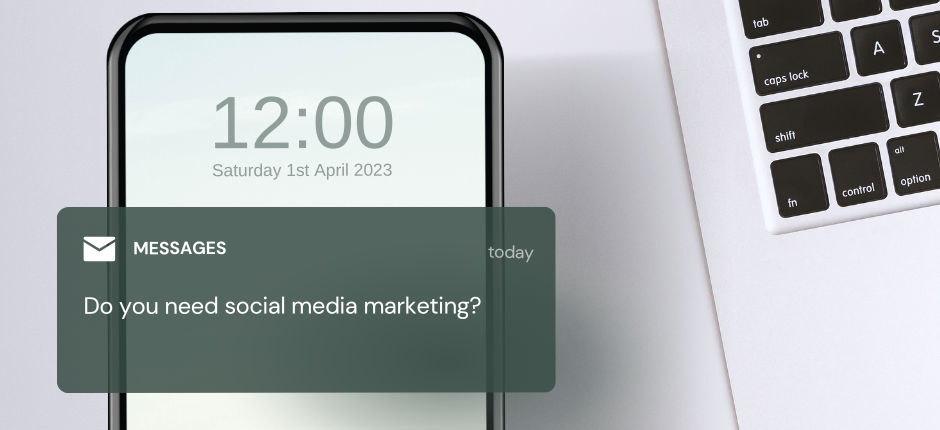
Social media advertising is a form of digital advertising where paid ads are placed specifically for your target audience on social media platforms such as Facebook, Twitter, or Instagram.
In the online world, it is becoming more and more difficult to get noticed by your potential customers since their attention is becoming a scarce resource. That is why advertising through social media has increased and become an impactful tool as it allows you to deliver your message to your ideal buyers throughout their purchase journey. Even before launching a new product, you can already launch a brand awareness campaign on your favourite social media platform to make everybody wait for that product.
Let’s discuss why running social media ads can be beneficial for your business:
- The majority of your customers are on social media, which allows you to adopt a more nuanced approach to advertising – one that tailors the content based on individual preferences, interests, and behavioural traits.
- You have control and can optimise the campaign on the go. That is, you can modify the budget, targeting, deliveries, and creatives (visuals or other content added) of the ad whenever you want.
- It offers you new and modern ways of advertising. New targeting capabilities and ad formats are frequently introduced, for example, carousel ads, lead gen ads, canvas ads, etc. which didn’t exist before. Brands now largely rely on these ad formats.
- Just as a fact, according to the CMO survey, brands will almost double their budget allocated to social media advertising by 2023.
Seeing these reasons, it is clear how important advertising through social media has become for companies to grow their business.
What are the costs of advertising on social media?
There’s probably a big variety of social media ads, at different costs, that adapt to every type of business and budget. Ads in most social networks work a lot like Google Ads; that is, they are based on an auction format. You set a maximum bid for a target result (in this case, a click probably), or a maximum budget per day. There is no set amount. The good thing is that the ad manager interface in every platform will guide you and recommend a bid based on the goals you selected.
Depending on your goal, normally you pay according to one of these methods:
- Cost per 1000 impressions (CPM)
- Cost per Click (CPC)
- Cost per conversion
- Cost per video view
Some factors will impact how much you will have to pay for a social media ad, independently of what your competition is bidding:
- Quality of your ad
- Campaign goal
- Type of audience you target
- Target country
- Time of year (even time of day)
- Placement within the network
Tips on how to do social media ads
Since you might not know where to start, here are some tips on what to have into account first to run a successful social media ads campaign.
1. Know your business objectives and goals. As we have discussed before, this point is important to also define and control your budget.
2. Know your target audience. Make yourself the following questions:
- Who is your typical customer?
- How old are they?
- Are they male or female?
- What is their income and education level?
- What are they interested in outside of your product and service?
Be as specific as you can when it comes to choosing the right target audience. This will help you also define which social media platforms you should focus on.
3. Get help from your organic posts. Before trying something new in your ad campaign posts and visuals, experiment with it on your organic posts. If something works on the organic posts, we can assume that it will work with paid ads too as the target audience is fairly the same.
4. Design attractive creatives with multiple options. The success of your campaigns depends largely on the ad creatives (the visuals/design of the ad). To maximise the chances of success, hedge your opportunities by creating multiple ad creatives. It isn’t about running A/B tests. You can create two (or more) entirely different creatives for the same campaign. You can use distinct ad copies and visuals altogether. The platform will choose and push the ad that’s performing better to optimise your spending.
5. Make it mobile-friendly. Most social media ads are being viewed on mobile devices. Therefore, your mobile ads should be specifically designed for the small screen. Incorporate images that are easy to view on a pocket-sized device. Only when you specifically design your ad to be placed on a desktop can you avoid this step.
6. Test your ads and measure the results. Social media advertising tracks every single impression, click, and conversion on your ads. As it thrives on data, the decisions are guided by what’s working and not by your gut feelings. There is no doubt that it is one of the most impactful ways to drive genuine engagement and conversions.
How to choose the right social media advertising platform for your business
Once you have defined your target audience and your goals, it is time to talk about where to do social media advertising. There are a variety of social media platforms available today, but not all of them are the best for your business.
Here we will talk about the principal social media platforms so you can decide which one/s is the best for your social media ads.
Facebook is the most popular and largest social media platform, with one of the largest user bases (also you can add Instagram, Whatsapp, and Messenger). Aside from having an enormous potential audience, it is also very visual and offers multiple and detailed segmentation (demographics, etc). Taking into account all of this, it is never a bad option to choose Facebook ads to start with. The only problem with Facebook is that it may be hard to reach a new audience because there are already a lot of people on Facebook, and your posts have a limited reach, even within your own networks. But if your goal is to build a dedicated following of clients and you need a way to keep in touch with them, this is a great option for your business.
Instagram is one of the fastest-growing platforms, especially among a young audience. Instagram relies on photos or videos for conversation. As a result, this platform works well for visual-based businesses, like art, food, retail, and beauty. Also, you can manage ads for Facebook and Instagram through the same interface: Facebook Ad Manager. You can target people on Instagram based on their location, demographics, interests, and behavioural characteristics. Instagram also lets you create custom and lookalike audiences to find new users that share similar characteristics to your ideal buyer.
LinkedIn is a business-oriented platform and brings opportunities for brands and individuals alike to promote themselves. It boasts the largest users among ages 30-49 and is the most utilised platform for older audiences. The targeting options on LinkedIn are different compared to the other platforms and primarily revolve around professional criteria such as education, organization size, sector, job title, etc. As a result, the platform is useful for B2B lead generation, general networking, as well as recruiting employees.
Twitter is an excellent platform to build awareness for your brand. Twitter utilises the hashtag, which organises conversations around a word or phrase. By searching hashtags, you can learn what people are talking about so you can craft your tweets to take part in popular conversations. Why would you do this? Because Twitter can offer insight into what topics are trending. Twitter is often used by news outlets to find stories. Since Twitter is often used to provide real-time updates to an audience, many brands combine Twitter with offline engagement, such as events.
Pinterest is used for saving content by “pinning” photos or videos to a virtual bulletin board. Females are predominant on Pinterest and the most common pins are recipes, style ideas, striking photographs, and DIY crafts. Since Pinterest is a visual-based platform, you’ll need strong graphics to engage users. Businesses have been using Pinterest successfully for strong retail sales.
Snapchat
Snapchat is famous among the millennials and Gen Z audience and therefore favours content that is casual and fun. So if your target audience includes these two generations, don’t hesitate to use Snapchat!
Tik Tok
TikTok is known for its short-form videos and normally has a very young demographic. The platform is useful for targeting the 18-24 age group and building brand awareness. Like Pinterest and Instagram, TikTok is best for visual-based businesses like art, food, retail, beauty, and some service industries.
Youtube
Youtube is one of the most famous platforms worldwide, with people creating content from all over the globe. Also, you don’t have to sign up to be a user to view the content Youtube has to offer. As a result, YouTube has become one of the biggest search engine platforms. Many of these searches are for “How To” videos and it allows you to reach a bigger audience. Service industry businesses that can offer this type of content work well on this platform, along with lifestyle and educational videos.
Start running your social media ads!
Now that you have defined your audience, and goals and selected the perfect social media platforms to run ads for your business to be successful, start trying to test campaigns and get more customers!
Contact us if you require any help with your social media.


